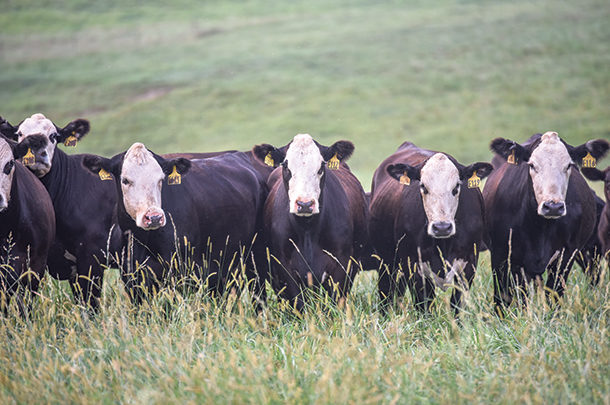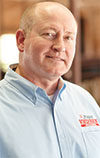For nearly 60 years, carcass weights for finished cattle have been on a linear increase. As an industry, we have not practiced single-trait selection for cow size. However, we have unknowingly increased cow size by selecting for growth.
We keep the bigger, older heifers because those are the ones that will have a better chance of getting bred and rebreeding the next year. Breeding with growthier heifers and bulls has resulted in heavier mature weights. The obvious advantage is heavier weaning weights. But at some point, doesn’t common sense say cow size has to plateau?
There is some debate on how big cattle can get before it creates problems with packing plant shackle space (again) or compromises consumer eating experiences (steaks bigger than the plate). Lost in these conversations is what increased carcass weight means for mature cow size and, consequently, cow nutrition requirements.
There is no data on average cow size in the U.S. It does not exist. But you can back-calculate using current steer carcass weight trends, which suggests that the national average mature cow weight is approximately 1,400 pounds. Yet, many in the industry still use grazing recommendations for cows that weigh 1,000 pounds. Even stocking density measures such as animal unit months (AUM) – a standardized calculation of carrying capacity for forage using cattle weight – still utilize 1,000 pounds as the standard measurement.
There are some 1,000-pound cows in the U.S., but many weigh above the national estimated average of 1,400 pounds. For example, if we’re looking at a 1,500-pound average cow weight for a herd, those animals have 1.5 times more nutrient requirements than most historical recommendations support.
To meet nutrient needs, cows require more forage from additional land area. In theory, that means you need 1.5 times more land than Grandpa and Grandma did to run the same number of cows. Unfortunately, land isn’t easy to come by. Some ranches can’t supply adequate forage to their cow herd, and it is evidenced by poorer body condition and conception rates. The long-term impacts mean we could jeopardize the sustainability of our range or pasture.
So what can you do to manage through this conundrum? Here are some ways to help match cow size to nutrition needs.
Check the scales
The first step is to get an approximate weight for the mature cow herd. Not everyone has access to scales, but there are some ways to get weights for at least a portion of the herd.
When cows sell at local auction markets, it’s by the pound. Look at past sales receipts and calculate the average weight for cull cows, which can be applied for most of the herd. Or if you haul cows to pasture, weigh a few loads on truck scales located at a local grain elevator or cooperative.
If you do have scales, weigh cows as a routine part of the management plan. Take weights when cows are going through the working facilities for events like pregnancy checks or vaccinations.
Keeping a database with cow weights can help make decisions for herd improvement easier.
Right-size approach
With your baseline average cow size established, then it’s time to match the AUMs to pasture carrying capacity.
Ideally, we’d stock pastures by pounds of cattle per acre instead of cows per acre. Stocking by pounds of cattle per acre helps better manage your grazing resources. Larger animals will need more pounds of forage than smaller animals.
If cows are 40% bigger, generally speaking, they’ll need 40% more land and forage to meet their needs. Genetic improvements for parameters such as feed efficiency will play a role, so this doesn’t always hold true. If a 1,500-pound cow has a weaning weight ratio 50% of her bodyweight, and she eats the same amount of feed as a 1,000-pound cow, it’s a home run. That’s where future genetics will take us – but until that occurs, it’s important to keep weight measurements for the cow herd and stock by pounds of cattle per acre.
Those huge cows often have the poorest weaning weight ratios. It might be difficult to cull a bred cow, and nobody wants to reduce calf crop weaning weights by culling big cows that produce big calves. But when big cows wean a low percentage of their bodyweight, they aren’t paying for themselves. Selling the largest cows in the herd to lower the overall pounds per acre is a simple way to manage stocking density. Then you can select replacement females from moderate-sized cows to help pull the mature cow size down.
Breeding to more moderate-sized bulls is a long-term tactic to reduce overall mature cow weights.
Supplement as needed
Most of the cow herd’s nutrition should come from grazed forages. This maximizes herd profitability by reducing the need for supplemental feed and forages.
In general, a large cow needs additional supplemental feed, whether that’s forage or protein and energy supplements. It all gets back to managing body condition. Bigger cows require more overall nutrients than smaller cows to maintain a body condition score of 6.
If reducing cow numbers for a right-sized approach isn’t an option, supplying additional nutrients through supplemental protein and energy via meal, tubs or liquid can act as a stopgap. However, for profitability’s sake, it’s best to use as many grazing resources as possible without negatively impacting the pasture’s longevity.
For those who can feed hay, don’t ignore it in the supplement conversation, either. When pasture forage is in short supply, providing hay can help reduce the expense of purchasing feedstuffs. Don’t force cows to clean up all of their hay – generally, what they leave behind is stemmy, weedy and tough to eat. Keep your bale feeder or feed grounds stocked with enough hay, and the cows will eat what they need.
Also, consider your mineral consumption. Larger cows will eat more mineral than their smaller counterparts – more than what the feed tag suggests. Most minerals will target 4 ounces of mineral consumption per head per day. A simple way to ensure cows are getting the mineral they need is to have it available year-round and always make sure the feeder is full.
Involve your nutritionist in your grazing and feeding programs. They can help ensure cows receive the right balance of nutrients, no matter their size. Use sound advice and management to help guide decision making for your cow herd. Ultimately, the choice to halt the increasing size of cattle will be driven by land carrying capability at a local level.
For more tips to improve your breeding program, visit Purina Mills.








